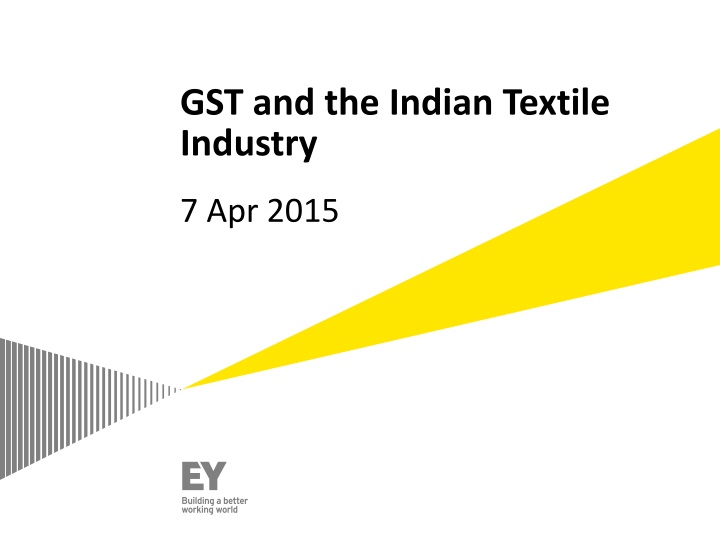
Implications of GST on Indian Textile Industry
Learn about how the implementation of GST is affecting the Indian textile industry, including the taxes being replaced, advantages, key effects, features of GST in India, and the specific characteristics of the textile industry. Explore the potential impact on resource allocation, productivity, competitiveness, and more.
Download Presentation

Please find below an Image/Link to download the presentation.
The content on the website is provided AS IS for your information and personal use only. It may not be sold, licensed, or shared on other websites without obtaining consent from the author. If you encounter any issues during the download, it is possible that the publisher has removed the file from their server.
You are allowed to download the files provided on this website for personal or commercial use, subject to the condition that they are used lawfully. All files are the property of their respective owners.
The content on the website is provided AS IS for your information and personal use only. It may not be sold, licensed, or shared on other websites without obtaining consent from the author.
E N D
Presentation Transcript
GST and the Indian Textile Industry 7 Apr 2015
Taxes to be Replaced by GST Main Taxes to be replaced are: Central taxes Central excise duties and Service tax along with all relevant cesses and surcharges State taxes State VAT Central sales tax and Entry tax Implications of GST for Indian Textile Industry Page 2
Main Advantages of GST Indian Wide Common Market Absence of Fiscal Barrier (CST/Entry Tax) Single or limited number of rates Production efficiency: Resource allocation; no incentive for vertical integration Consumption efficiency Minimization of classification disputes Improved compliance Note that the new constitutional amendment bill proposes a 1% tax on all inter-state supplies Page 3
Key effects of GST GST Reform Improved Resource Allocation Lower Price of Capital Goods Higher Total Productivity Larger Capital Stock Improved Competitiveness Higher Potential Output Implications of GST for Indian Textile Industry Page 4
Features of GST in India Dual GST: CGST and SGST Dual rate structure Lower rate: 12 % Standard rate: Estimates range from 20-27% for the composite rate Exempt category Exports zero-rated, imports taxable Inter-state sales subject to IGST=(CGST+SGST) Page 5 Implications of GST for Indian Textile Industry
Features of Textile Industry Large unorganized sector Large employment potential Mix of traditional and modern Low tax incidence Differentiated segments; composite products High export contribution and potential Page 6
Share of Textiles in Potential GST Tax Base 16.00 70.0 14.00 60.0 12.00 50.0 10.00 40.0 8.00 30.0 6.00 4.00 20.0 2.00 10.0 0.00 2004-05 2006-07 2008-09 2010-11 2012-13 0.0 1970-71 1972-73 1974-75 1976-77 1978-79 1980-81 1982-83 1984-85 1986-87 1988-89 1990-91 1992-93 1994-95 1996-97 1998-99 2000-01 2002-03 Clothing and furnishing (% to PFCE) PFCE excluding food, education, and health Page 7
Key aspects of current taxation system as it applies to Textiles Usually low/ zero rates of taxes on final products Tax is shifted back to production (as opposed to consumption) leading to blocked input taxes and higher cost of production Inefficiencies in production Exemption of production inputs Duty Drawback Scheme Exemption by size of operation, giving rise to fragmentation of industry Complexities in compliance and administration Ad-hoc or piecemeal efforts to apply tax leads to significant opposition from all segments of textiles industry. Any piecemeal tax is complex, creates competitive distortions and is subject to collusion/ harassment by Tax Administration authorities Implications of GST for Indian Textile Industry Page 8
Key aspects of current taxation system Classification disputes Fabrics vs garments, e.g. should Sarees be treated as fabrics or as readymade garments Lack of Fibre neutrality Cotton fibre vs manmade fibre. Cotton fibre treated favorably as compared to man- made fibres Effective tax rates vary by degree of integration Power looms vs Composite mills. Effective tax rates for composite mills higher than that of power looms discouraging integration of production adversely affecting efficiency Implications of GST for Indian Textile Industry Page 9
Textile segments Nine broad categories Khadi and handlooms Cotton textiles Woollen textiles Silk textiles Artificial silk and synthetic fibre textiles Jute, hemp, and mesta textiles Carpet weaving Ready-made garments Miscellaneous textile products 1. 2. 3. 4. 5. 6. 7. 8. 9. Page 10 Implications of GST for Indian Textile Industry
Key concerns of textiles industry Break in input tax credit chain leads to blocked input taxes Complexities and distortions related to Small Business Threshold High compliance cost, especially for small units Lack of uniformity in Centre and States taxes: e.g., presently Job Workers are treated differentially under CENVAT and State VAT Continuing blockage of input taxes under GST Petroleum products, Electricity, Real estate Possibility of some the taxes continuing after GST: e.g. Octroi, Entry tax, Electricity duty Implications of GST for Indian Textile Industry Page 11
Estimated share of textile segments in tax base Relative Shares in Estimated GST Tax Base (%) 1.2 Textile Outputs Khadi, cotton textiles (handlooms) Cotton textiles 39.5 Woollen textiles 4.3 Silk textiles 1.6 Art silk, synthetic fibre textiles 18.7 Jute, hemp, mesta textiles 0.8 Carpet weaving 1.0 Readymade garments 16.3 Miscellaneous textile products 16.6 Total 100.0 Page 12 Implications of GST for Indian Textile Industry
Input structure across the nine textile categories - Shares by types of inputs Synthetic fibres, Woollen textiles textile products synthetic fibre Carpet weaving Miscellaneous Cotton textiles Khadi, cotton mesta textiles Readymade Jute, hemp, (handlooms) Silk textiles garments Art silk, textiles textiles resin Structure of Inputs Textile inputs 46.3 52.1 45.1 38.7 40.6 38.4 42.2 47.1 41.3 14.1 Non-textile inputs (goods) 16.2 11.9 19.5 25.2 28.4 19.5 19.9 16.5 23.4 58.4 Non-textile inputs (services) 36.5 34.2 33.9 35.0 29.7 39.6 36.7 35.3 33.6 22.4 Total Non-textile inputs 52.7 46.1 53.4 60.2 58.1 59.0 56.6 51.9 57.0 80.7 Non-textile inputs (not shown) 1.0 1.8 1.4 1.0 1.3 2.5 1.2 1.0 1.7 5.2 Total 100.0 100.0 100.0 100.0 100.0 100.0 100.0 100.0 100.0 100.0 Implications of GST for Indian Textile Industry Page 13
Current Effective Tax Rates (RNR) - Combined for Centre and States RNR (%) Textile Categories Khadi, cotton textiles (handlooms) 4.0 Cotton textiles 7.1 Woollen textiles 9.3 Silk textiles 9.6 Art silk, synthetic fibre textiles 10.2 Jute, hemp, mesta textiles 9.0 Carpet weaving 5.6 Readymade garments* 10.5 Miscellaneous textile products 12.0 All Segments 9.3 Implications of GST for Indian Textile Industry Page 14
Price and Income Effects - Net effect on demand due to a shift to GST from the current indirect tax structure Category Base price Base+ Present Taxes Base+GST Increase in price (%) Change in demand (own price relative to all prices effect) (%) Change in demand (income effect (%) Net Change in demand (%) Khadi, cotton textiles (handlooms) 100 104.0 112 7.7% -2.2% 0.8% -1.4% 100 100 100 107.1 109.3 109.6 112 112 112 4.6% 2.4% 2.2% -1.3% -0.7% -0.6% 0.8% 0.8% 0.8% -0.5% 0.1% 0.1% Cotton textiles Woolen textiles Silk textiles Art silk, synthetic fiber textiles Jute, hemp, mesta textiles Carpet weaving Readymade garments Miscellaneous textile products 100 110.2 112 1.6% -0.5% 0.8% 0.3% 100 109.0 112 2.8% -0.8% 0.8% 0.0% 100 105.6 112 6.1% -1.7% 0.8% -1.0% 100 110.5 112 1.4% -0.4% 0.8% 0.4% 100 112.0 112 0.0% 0.0% 0.8% 0.7% 100 109.3 112 2.5% -0.7% 0.8% 0.0% Total Assumption: GST is levied at a single rate of 12% Page 15
Key empirical findings Overall current RNR lower than the sum of lower CGST and SGST rates (12%); implies additional tax burden Blocked input taxes are relatively more for State VAT since output tax rates are zero for most categories compared to Cenvat where Input Cenvat on goods and service tax on service inputs are both rebated Category-wise RNR is highest for ready made garments and artificial silk and synthetic fibre textiles Page 16 Implications of GST for Indian Textile Industry
Likely impact of GST If applied uniformly, GST is likely to address all concerns of industry It will eliminate any blockage of input taxes caused due to break of input tax credit chain Provide level playing field to all segments of textile industry Shift in tax burden from Production to Consumption (GST is a Consumption Tax) Significant simplification in compliance due to GSTN VAT rates on textiles in some international jurisdictions South Asia: Pakistan (5%), Bangladesh (15%), Sri Lanka (12%) Developed nations: Australia (10%), New Zealand (15%), Japan (5%, 8% from 1 April 2014 and 10% from 1 Oct 2015), UK (20%), Germany (19%), France (19.6%) China: 13%, 3% for SMEs without input tax credit Implications of GST for Indian Textile Industry Page 17
Likely impact of GST Key concern Increase in tax burden from 9.3% to possibly 12% which may lead to a reduction in demand However overall impact may not be negative Greater efficiency in production may lead to downward movement of prices Exports may go up due to true zero rating A major reform like GST will lead to higher GDP and higher disposable incomes Price and Income elasticity of demand may compensate for each other Implications of GST for Indian Textile Industry Page 18
Key effects of GST If all textile categories are put at the lower CGST and SGST rates, key effects will be as follows: Transparency effect 1. Tax burden will be more transparent since blocked input taxes will be eliminated, all input taxes will be fully rebated Automatic zero-rating of exports 2. Some of the present export-subsidy schemes may need to be redesigned or eliminated; thus, exports will be encouraged under GST without the need for explicit subsidy schemes Additional Revenue Effect 3. The overall tax incidence on textile products will increase; the additional revenue can be used to redesign subsidy scheme for mitigating adverse impact on lower income groups; a distinction may need to be made between product groups where RNRs are close to the average and products where they are considerably lower Page 19 Implications of GST for Indian Textile Industry
Key effects of GST Present zero-rating of textile outputs in the case of State VAT will go away and 4. taxes paid on capital goods and textile machinery will also be rebated Productivity Enhancing Effects; Improvement in allocative efficiency; modernization 5. of textile sector encouraged Improved Compliance Effect 6. With input tax credit at each stage of value added and creation of information chain, there would be automatic improvement in compliance Keeping the same GST rate for all textile segments will facilitate further experimentation 7. in mixing and blending as it can be done without any tax implication Present GST discussions indicate that cascading may continue with respect to petroleum 8. products that serve as inputs; to that extent the burden on artificial silk and synthetic fibres will continue; since much of these products are exported, this disadvantage may continue unless a suitable mechanism is found to rebate input tax on petroleum products Page 20 Implications of GST for Indian Textile Industry
Policy Options under GST Key objective for options should be: Production efficiency Market Neutrality Minimize incremental burden on lower-income households A uniform and comprehensive GST most conducive for production efficiency and market neutrality Minimizing incremental burden on lower-income households is the remaining policy objective that could warrant deviation from a uniform GST Page 21
Pattern of expenditure on essential items in Urban India - Share of Monthly per capita expenditure 2011-12 Fractile Class Basic FoodProcessed Fuel and light 11.4 10.5 9.7 9.0 8.6 8.1 7.5 7.1 6.7 6.1 5.6 4.1 6.7 Clothing & bedding 6.8 6.3 6.2 6.2 6.0 6.0 5.8 5.7 5.4 5.2 5.2 4.2 5.4 Other Medical Total Food 7.0 7.8 7.5 7.6 7.7 8.2 7.7 8.3 8.6 8.9 9.7 11.5 9.0 expenditure 19.5 21.0 23.7 26.0 28.2 31.1 32.7 35.3 38.5 42.2 46.4 57.5 39.8 52.2 50.8 48.7 46.8 45.0 42.0 40.8 38.1 35.3 31.6 26.7 16.4 33.6 3.0 3.6 4.2 4.3 4.5 4.6 5.5 5.5 5.6 6.0 6.4 6.4 5.5 100 100 100 100 100 100 100 100 100 100 100 100 100 0-P5 P5-P10 P10-P20 P20-P30 P30-P40 P40-P50 P50-P60 P60-P70 P70-P80 P80-P90 P90-P95 >P95 All Implications of GST for Indian Textile Industry Page 22
Policy options Zero rating Exemption Lower rate of tax Standard rate of tax with appropriate subsidies Implications of GST for Indian Textile Industry Page 23
Policy options - Pros and Cons Zero rating Zero rating is possible only if all Input taxes are refunded Most jurisdictions find it difficult to administer and monitor input tax refunds Zero-rating in India proposed to be limited to exports Exemption Most distorting option Results in higher tax incidence due to blocked input taxes and tax cascading Shifts tax burden from Consumption to Production Exemption to fabrics leads to pressure from industry for exemption from production inputs as well. This leads to complex administration of tax Implications of GST for Indian Textile Industry Page 24
Policy options - Pros and Cons Lower rate of tax Advisable only if government chooses to have a lower GST rate Lower rate should be extended to all fabrics and personal wear items to avoid classification disputes and market distortions However, difficult choices to be made: Fabrics Vs Apparel for personal wear Home textiles Technical textiles If inputs are taxable at higher rate and outputs are taxable at lower rate, refund and monitoring of refunds issues will arise Standard rate of tax with appropriate subsidies Clean tax system Achieves production efficiency, which is the key concern as opposed to the regressivity of the tax system Can be accompanied by an appropriate subsidy regime to support weakest segments of the textile industry Implications of GST for Indian Textile Industry Page 25
Supplementary Slides Page 26
Pattern of expenditure on essential items in Rural India - Share of Monthly per capita expenditure 2011-12 Fractile class Basic Food 52.9 52.4 52.7 51.7 51.1 50.1 49.3 47.8 46.4 44.0 39.9 30.8 45.0 Processed Food 7.7 7.8 7.6 7.5 7.8 8.0 7.7 7.9 7.8 7.8 7.7 8.7 7.9 Fuel and light 12.4 11.4 10.6 10.2 9.5 9.1 8.8 8.4 7.9 7.4 6.6 4.5 8.0 Clothing & bedding 7.4 7.2 6.9 6.7 6.6 6.6 6.6 6.2 6.0 5.8 5.5 4.4 6.0 Other Medical Total expenditure 16.6 17.5 18.2 19.1 20.4 21.4 22.2 24.2 25.5 27.8 31.6 40.5 26.5 3.1 3.8 4.0 4.7 4.7 4.9 5.4 5.5 6.4 7.2 8.7 11.0 6.7 100 100 100 100 100 100 100 100 100 100 100 100 100 0-P5 P5-P10 P10-P20 P20-P30 P30-P40 P40-P50 P50-P60 P60-P70 P70-P80 P80-P90 P90-P95 >P95 All Implications of GST for Indian Textile Industry Page 27






